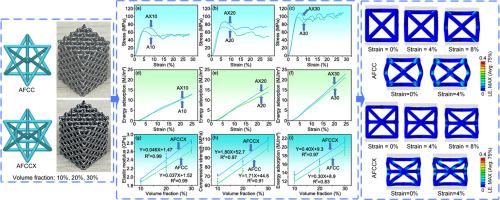耦合AFCCX拓扑与体积分数控制,设计电子束熔化高性能晶格结构,用于潜在的骨科应用
IF 14.3
1区 材料科学
Q1 MATERIALS SCIENCE, MULTIDISCIPLINARY
引用次数: 0
摘要
晶格结构以其高刚度重量比和显著的能量吸附能力而闻名。尽管全面心x柱立方结构(AFCCX)和原始立方结构(AFCC)均表现出令人满意的力学性能,但体积分数和拓扑结构对其力学性能的耦合影响尚不明确。本文采用电子束熔化法制备了体积分数分别为10%、20%和30%的Ti-6Al-4V AFCC和AFCCX结构,并系统地研究了它们的变形行为。与AFCC结构相比,AFCCX结构的力学性能得到改善,弹性模量提高1.4% ~ 10.3%,抗压强度提高8% ~ 12%,能量吸收提高8.0% ~ 14.5%(25%应变)。x柱有效地分散了AFCCX中的局部应变,抑制了变形过程中胞体的膨胀。因此,AFCCX结构中有更多的支柱承担荷载,从而提高了结构效率。值得注意的是,x-struts不能直接承受外部载荷。它们确实有助于适度提高结构的刚度和强度,从而促进更有效的工程。这项工作为晶格结构的直接设计和优化提供了有价值的概念。本文章由计算机程序翻译,如有差异,请以英文原文为准。

Coupling AFCCX topology with volume fraction control to engineer electron beam melted high-performance lattice structures for potential orthopedic application
Lattice structures are renowned for their high stiffness-to-weight ratios and remarkable energy adsorption capabilities. Although both the all-face-centered cubic with x-struts (AFCCX) structure and its original counterpart (AFCC) manifest satisfactory mechanical performance, the coupling influence of volume fraction and topology on their mechanical properties remains elusive. This work employed electron beam melting to fabricate Ti-6Al-4V AFCC and AFCCX structures with volume fractions of 10%, 20%, and 30% and systematically investigated their deformation behavior. Compared to the AFCC structures, the AFCCX structures demonstrate improved mechanical properties, with the elastic modulus increasing by 1.4%–10.3%, the compressive strength increasing by 8%–12%, and the energy absorption increasing by 8.0%–14.5% (25% strain). The x-struts effectively disperse the local strains in AFCCX and suppress the expansion of the cell during deformation. Therefore, more struts in the AFCCX structure are engaged in bearing the load, leading to an augmented structural efficiency. Notably, the x-struts cannot directly sustain the external loads. They do contribute to a modest enhancement in the stiffness and strength of the structures, thereby facilitating more effective engineering. This work offers valuable concepts for the straightforward design and optimization of lattice structures.
求助全文
通过发布文献求助,成功后即可免费获取论文全文。
去求助
来源期刊

Journal of Materials Science & Technology
工程技术-材料科学:综合
CiteScore
20.00
自引率
11.00%
发文量
995
审稿时长
13 days
期刊介绍:
Journal of Materials Science & Technology strives to promote global collaboration in the field of materials science and technology. It primarily publishes original research papers, invited review articles, letters, research notes, and summaries of scientific achievements. The journal covers a wide range of materials science and technology topics, including metallic materials, inorganic nonmetallic materials, and composite materials.
 求助内容:
求助内容: 应助结果提醒方式:
应助结果提醒方式:


